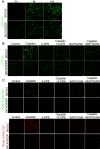Failure of Elevating Calcium Induces Oxidative Stress Tolerance and Imparts Cisplatin Resistance in Ovarian Cancer Cells
- PMID: 27330840
- PMCID: PMC4898922
- DOI: 10.14336/AD.2016.0118
Failure of Elevating Calcium Induces Oxidative Stress Tolerance and Imparts Cisplatin Resistance in Ovarian Cancer Cells
Abstract
Cisplatin is a commonly used chemotherapeutic drug, used for the treatment of malignant ovarian cancer, but acquired resistance limits its application. There is therefore an overwhelming need to understand the mechanism of cisplatin resistance in ovarian cancer, that is, ovarian cancer cells are insensitive to cisplatin treatment. Here, we show that failure of elevating calcium and oxidative stress tolerance play key roles in cisplatin resistance in ovarian cancer cell lines. Cisplatin induces an increase in oxidative stress and alters intracellular Ca(2+) concentration, including cytosolic and mitochondrial Ca(2+) in cisplatin-sensitive SKOV3 cells, but not in cisplatin-resistant SKOV3/DDP cells. Cisplatin induces mitochondrial damage and triggers the mitochondrial apoptotic pathway in cisplatin-sensitive SKOV3 cells, but rarely in cisplatin-resistant SKOV3/DDP cells. Inhibition of calcium signaling attenuates cisplatin-induced oxidative stress and intracellular Ca(2+) overload in cisplatin-sensitive SKOV3 cells. Moreover, in vivo xenograft models of nude mouse, cisplatin significantly reduced the growth rates of tumors originating from SKOV3 cells, but not that of SKOV3/DDP cells. Collectively, our data indicate that failure of calcium up-regulation mediates cisplatin resistance by alleviating oxidative stress in ovarian cancer cells. Our results highlight potential therapeutic strategies to improve cisplatin resistance.
Keywords: calcium; cisplatin resistance; ovarian cancer; oxidative stress.
Figures







References
-
- Pils D, Bachmayr-Heyda A, Auer K, Svoboda M, Auner V, Hager G, Obermayr E, Reiner A, Reinthaller A, Speiser P et al. (2014). Cyclin E1 (CCNE1) as independent positive prognostic factor in advanced stage serous ovarian cancer patients - a study of the OVCAD consortium. Eur J Cancer, 50(1):99-110. - PubMed
-
- Agarwal R, Kaye SB (2003). Ovarian cancer: strategies for overcoming resistance to chemotherapy. Nat Rev Cancer, 3(7):502-516. - PubMed
-
- Tummala MK, McGuire WP (2005). Recurrent ovarian cancer. Clin Adv Hematol Oncol, 3(9):723-736. - PubMed
LinkOut - more resources
Full Text Sources
Other Literature Sources
Miscellaneous
